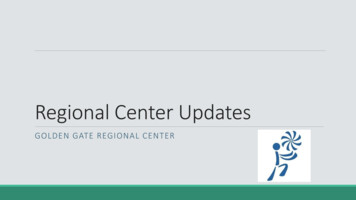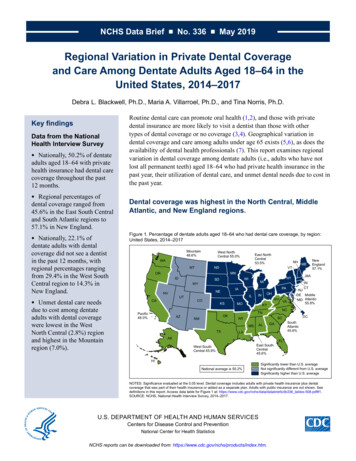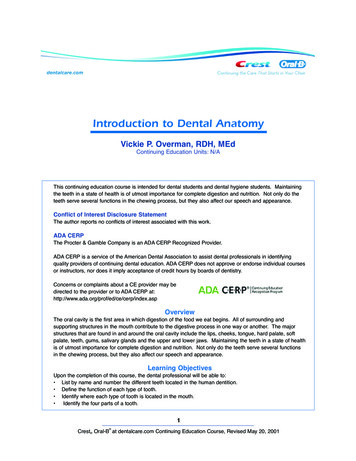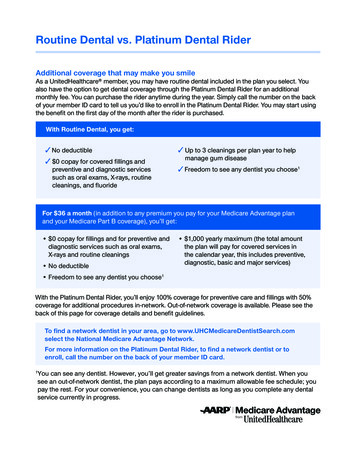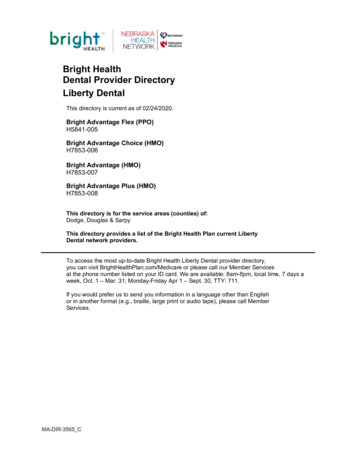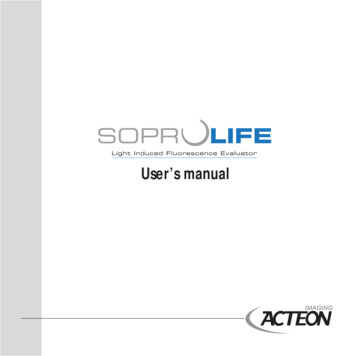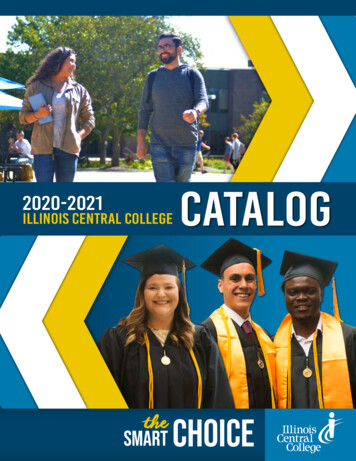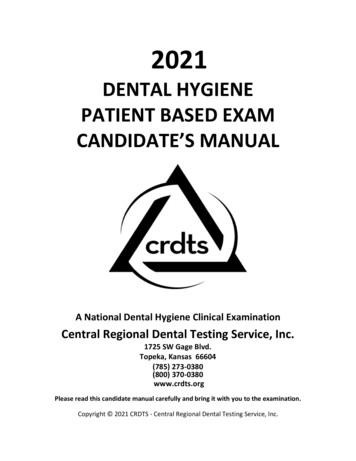
Transcription
2021DENTAL HYGIENEPATIENT BASED EXAMCANDIDATE’S MANUALA National Dental Hygiene Clinical ExaminationCentral Regional Dental Testing Service, Inc.1725 SW Gage Blvd.Topeka, Kansas 66604(785) 273-0380(800) 370-0380www.crdts.orgPlease read this candidate manual carefully and bring it with you to the examination.Copyright 2021 CRDTS - Central Regional Dental Testing Service, Inc.1
2021 CRDTS Hygiene Exam ScheduleCheck CRDTS website to confirm which exams are Patient Based & Simulated Patient (Manikin) ExamsExam Dates Exam SiteJanuary 8 – 10February 19-21March 19 – 20March 19 – 21March 19 – 21March 19 – 21March 26 – 28March 26 – 28April 9 – 11April 9 – 11April 9 – 11April 16 – 18April 16 – 18April 16 – 18April 16 – 18April 16 – 18April 23 – 25April 23 – 25April 23 – 25April 24 – 25April 30 – May 2April 30 – May 2April 30 – May 2April 30 – May 2April 30 – May 2April 30 – May 2April 30 – May 2May 7 – 9May 7 – 9May 7 – 9May 7 – 9May 7 – 9May 7 – 9May 13 – 14May 14 – 16May 14 – 16May 14 – 16May 14 – 16May 14 – 16May 14 – 16May 21 – 23May 21 – 23May 21 – 23May 21 – 23May 21 – 23June 4 – 6June 4 – 6June 11 – 13June 11 – 13June 11 – 13June 11 – 13June 11 – 13June 18 – 20July 16 – 18July 16 – 18July 16 – 18July 16 – 18August 13 – 15September 10 – 12September 10 – 12October 15 – 17October 15 – 17October 15 – 17October 15 – 17October 15 – 17December 3 – 5December 3 – 5December 3 – 5CityFortis AtlantaConcorde San BernardinoSacramento City CollegeConcorde DallasConcorde San AntonioOregon Institute of TechnologyColorado Northwestern CCLewis & Clark Community CollegeCarrington CollegeCentral Georgia Technical CollegeClayton State UniversityWallace State Community CollegeAtlanta Technical CollegeUniversity of Hawaii – ManoaPima Medical InstituteTrident Technical CollegeSavannah Technical CollegeBlinn CollegeMadison CollegeCreighton UniversityLanier Technical CollegeCarl Sandburg CollegeParkland CollegeSouthern Illinois UniversityLake Superior CollegeUniversity of NebraskaNorth Dakota State College of ScienceAugusta UniversityWichita State UniversityCentury CollegePima Medical InstituteChippewa Valley Community CollegeMilwaukee Area Technical CollegeNormandale Community CollegeCommunity College of DenverConcorde AuroraPacific UniversityMidlands Technical CollegeUniversity of South DakotaSheridan CollegePueblo Community CollegeHawkeye Community CollegeDel Mar CollegeWharton County Junior CollegeNortheast Wisconsin Technical CollegeDiablo Valley CollegeEast Tennessee State UniversityFresno City CollegeOxnard CollegeFortis CollegeJohnson County Community CollegeYakima Valley CollegePima Medical InstituteGeorgia State University – PerimeterLake Land CollegeSt. Louis Community CollegeAmarillo CollegeHerzing UniversityCarrington CollegeIndian Hills Community CollegeConcorde Career CollegeConcorde Career CollegeConcorde Career CollegeConcorde Career CollegePima Medical InstituteFortis CollegeLewis & Clark Community CollegeMilwaukee Area Technical CollegeStateAtlantaSan BernardinoSacramentoDallasSan AntonioKlamath aleDuluthLincolnWahpetonAugustaWichitaWhite Bear LakeSeattleEau umbiaVermillionSheridanPuebloWaterlooCorpus CristiWhartonGreen BayPleasant HillJohnson CityFresnoOxnardAtlantaOverland ParkYakimaHoustonDunwoodyMattoonForest ParkAmarilloMinneapolisSacramentoOttumwaSan BernardinoAuroraDallasSan TXMNCAIACACOTXTXTXGAILWIDeadlineDecember 4January 15February 5February 5February 5February 5February 12February 12February 26February 26February 26March 5March 5March 5March 5March5March 12March 12March 12March 12March 19March 19March 19March 19March 19March 19March 19March 26March 26March 26March 26March 26March 26April 2April 2April 2April 2April 2April 2April 2April 9April 9April 9April 9April 9April 23April 23April 30April 30April 30April 30April 30May 7June 4June 4June 4June 4July 2July 30July 30September 3September 3September 3September 3September 3October 29October 29October 29
Table of ContentsIntroduction .1Application Information and Requirements .4Petition for Review .9Policy for Reexamination and Remediation .9Policy for On-site Retakes . 10Policy for Testing Disabled Candidates . 11Candidate Orientation Q&A’s . 12Dental Hygiene Examination Content and Scoring Overview . 12Professional Conduct . 13Examination Time Schedule Overview . 15Time Schedule for Treatment Selection Submissions . 16Treatment Selection Submission Options . 17General Directives and Information . 18Patient Acceptability and Health History Requirements . 22Treatment Selection Requirements . 24Performance Requirements . 27Administration of Anesthetics . 30Documentation of Anesthetics . 31Checklist of Required Exam Materials . 33Glossary . 34References . 35Forms:Treatment Consent Form .Health History .Progress Folder .Extra/Intra Oral Assessment and Perio Charting Form .Patient Screening Worksheet: Full Mouth .Patient Screening Worksheet: Treatment Selection .Treatment Selection Form .Medical Clearance Form .Shared Patient Form .Index .33637-3839-4142-4344-4546-4748-49505152
This page left intentionally blank.4
CRDTS 2021 HYGIENE PATIENT BASED EXAMCANDIDATE'S MANUALIntroductionThis manual has been designed to assist dental hygiene candidates in their preparation tobe a participant in this examination. Outlined below are general directives and informationfor the conduct of the examination.Mission Statement: To provide the dental examination community with test constructionand administrative standardization for a national uniform dental hygiene clinical licensureexamination. The examination will demonstrate integrity and fairness in order to assist StateBoards with their mission to protect the health, safety and welfare of the public by assuringthat only competent and qualified individuals are allowed to practice dental hygiene.Purpose: The purpose of this examination is to assess the candidate’s professionalknowledge, skills, abilities and judgment (KSAJ’s) as applied in clinical treatment proceduresthat are a representative sample of the services that are provided in the practice of dentalhygiene, based on the criticality of the procedure to the patient’s systemic and oral healthand the frequency with which that service is provided in practice.CRDTS: The Central Regional Dental Testing Service, Inc. (hereinafter abbreviated CRDTS)is an independent testing agency which develops and administers clinical competencyexaminations in dentistry and dental hygiene on behalf of its member and participating states.Regional testing agencies, such as CRDTS, do not have the authority to license individualsor to implement policy that goes beyond the laws of its member states. Regional testingagencies should not be confused with state boards of dentistry.CRDTS Member States: The Member States of CRDTS are Alabama, Arkansas, California,Georgia, Hawaii, Illinois, Iowa, Kansas, Minnesota, Missouri, Nebraska, New Mexico, NorthDakota, Oklahoma, South Carolina, South Dakota, Texas, Washington, West Virginia,Wisconsin, and Wyoming.CRDTS Recognizing Jurisdictions: In addition to the Member States listed above, severalnon-member states also recognize the results of the CRDTS examination. Currentinformation indicates approximately 40 State Boards recognize the CRDTS dental hygieneexamination results for initial licensure. Prior to submitting an application, candidates shouldcontact the State Board where they wish to seek licensure to confirm and verify exactlicensing requirements for that state, because there may be restrictions, limitations oradditional licensing requirements that have changed since the publication of this manual.Jurisdictional Authority: State Boards of Dentistry are each established by state law as theregulatory agencies of the dental profession, accountable to the state legislature and chargedwith protection of the public. Although all state laws are somewhat different, there arecommonalities in their responsibilities to regulate the profession through licensure1
requirements, to interpret and enforce the dental practice act, to discipline those licenseeswho practice unethically or illegally and to assess the competence of applicants for licensurein their jurisdictions through theoretical and clinical examinations. In order to fulfill theirmandate to evaluate competence, the CRDTS’ member State Boards have joined togetherto develop and administer skill-based examinations in dentistry and dental hygiene that arefair, objective and meet established principles of measurement for clinical evaluation.Candidate Ethical Responsibilities: Licensure as a dental health professional and thepublic trust, respect and status that accompanies it is both a privilege and a responsibility.Implicit in a State Board’s charge to protect the public is the responsibility to ensure thatpractitioners are not only competent, but also ethical. In addition to the American DentalHygienists’ Association’s Code of Ethics, there are codes of professional conduct within statelaws, and the requirements of many State Boards for periodic continuing education coursesin ethics for maintenance and renewal of licenses.During the examination process, there are policies, rules and standards of conduct that arepart of the candidate’s responsibility; the candidate is expected to read the entire Candidate’sManual and comply with all those rules and requirements.The dental hygiene practitioner is entrusted with the oral health and welfare of a patient andit is imperative that such trust be respected by candidates and that services to the patient’sneeds and well-being are always put first. In every step of the examination process, CRDTShas established policy and examination protocol to ensure that the welfare of patients issafeguarded. CRDTS will provide a consent form that documents the treatment the patient will receive,the fact that the candidate is not a licensed hygienist and a statement that the servicesprovided during the exam may not complete their treatment plan or totally fulfill their oralhealth needs. The consent form must be executed before the patient can be accepted. CRDTS will provide a health history form that screens for systemic conditions or medicalconsiderations that might put the patient at risk during the examination or requirepremedication in order for them to participate. The health history must be completelyfilled out and appropriate precautions taken before the patient can be accepted. If treatment is suspended or terminated for any reason, CRDTS will complete a FollowUp Form to document what additional treatment is necessary, who will provide it, and whowill be financially responsible. The patient is provided a copy of this form; and thecandidate must come to the exam with a “follow-up” plan about how the patient will beprovided a continuum of care after the exam, if such care should be needed. When patients are checked-in, examiners will review the health history, consent form andtreatment selection to see if it meets the criteria and is justified clinically. Throughout theexamination, examiners will be monitoring patients to see that they do not experience anyunnecessary discomfort.2
The CRDTS hygiene examination addresses many of the ethical concerns that have beenraised in recent years about the use of patients in clinical examinations. It is the responsibilityof candidates to solicit patient participation in an ethical manner. The candidate should fullyinform a prospective patient about the purpose, the process and the importance of a boardexamination, including the time involved, and the number of individuals who will be examiningthem. Copies of health history and treatment consent forms should be downloaded from theinternet at www.crdts.org and used to screen a patient’s health condition and plan anappropriate response to any medical issues that may impact the patient’s well-being duringand after the examination. Patients should be fully informed about their entire treatment plan,advised of alternative options or courses of treatment that might be advantageous to them,and how the procedure(s) to be completed during the examination are sequenced in a planwith due consideration given to the needs, desires and values of the patient. Patients shouldalso be advised of any benefits that may reasonably be expected as a result of participation.In the process of soliciting and screening patients, candidates should remain in compliancewith ethical considerations and refrain from the following: Reimbursements between candidates and patients in excess of that which would beconsidered reasonable for remuneration for travel, lodging, meals or loss of hourly wages. Remuneration to other licensure applicants or dental practitioners for acquiring patients. Utilizing patient brokering companies. Delaying treatment beyond that which would be considered acceptable in a typicaltreatment plan (e.g. delaying treatment for several months). Allowing themselves to be “extorted” by individuals who agree to participate in theexamination and then refuse to come at the appointed time unless they are paid a fee.Board examinations are conducted for the sole purpose of protecting the public by assessingthe competence of those who seek to practice dental hygiene. It is hoped that theprofessional and ethical management of patients by both CRDTS and the candidatesthroughout the examination process will leave the volunteer patients in better oral health withan increased respect for the profession’s diligence in maintaining high standards ofcompetence.Examiners: Candidates will be evaluated by examiners from the jurisdictions which compriseCRDTS. These examiners may be members of their State Boards or may have beenselected by their State Boards to serve as examiners. All examiners are trained andcalibrated to CRDTS exam criteria prior to each examination. In addition, there may beobservers at CRDTS’ exams such as faculty members from other schools, new CRDTS’examiners or examiners from other states. Such observers are authorized to participate incalibration and monitor all portions of the examination; however, they do not assign gradesor participate in the grading process.3
Test Development: In all aspects of test development, administrative protocol andevaluation methodologies, CRDTS strives to be aligned with and guided by: Standards for educational and psychological testing, published jointly by the AmericanEducational Research Association, the American Psychological Association and theNational Council on Measurement in Education AADB’s Guidance for Clinical Licensure Examinations in Dentistry Annual Statistical Analysis of each section of the exam along with summary statistics ofcandidate performance by school of graduation Statistical profiles for examiners’ self-assessment Technical Reports by measurement specialists Periodic Occupational AnalysesIn particular, the dental hygiene examination is developed and revised by the CRDTS DentalHygiene Examination Review Committee (ERC). The Dental Hygiene ERC is comprised ofrepresentatives from each of CRDTS’ Member States, as well as dental hygiene educatorsand special consultants. With both practitioners and educators involved, the Committee hasconsiderable content expertise from which to draw. The Committee also relies on practicesurveys, current curricula, and standards of competency to assure that the content andprotocol of the examination is current and relevant to practice. Determining the examinationcontent is also guided by such considerations as patient availability, logistical constraints andthe potential to ensure that a skill can be evaluated reliably.Application Information & RequirementsCRDTS offers two options for dental hygiene clinical licensure exams: Patient and SimulatedPatient (Manikin). These exams require different hardware, software and materials beshipped to exam sites. Due to these restrictions, candidates are required to choosewhich exam they will take when they register/apply for an exam and will not be allowedto switch to a different exam type at the site.Qualified candidates may apply to take the examination by submitting an application onlineat www.crdts.org. Once an application is completed online, it is considered a contract withCRDTS. If a candidate fails to fulfill all requirements of the application or is unable to takethe exam, the policies below will apply. Additional portions of the application can be uploadedonline. Detailed information regarding required documents/fees, test sites and examinationdates/deadlines are outlined on the CRDTS website and in this Manual. A fully executedapplication complete with the appropriate documentation and fee is required to take theexamination.Please read the entire application form before submitting any information. Be accurate andcomplete. If directions are not followed, the application may not be accepted.4
After completing the online application, the following items must be provided:Proof of Graduation:2021 Accredited Graduates: Candidates who have not yet graduated but are inthe final semester of their dental hygiene education must submit a “Letter of Certification” (aform provided by CRDTS) signed by their Program Director stating that they will successfullycomplete a prescribed course of study in a dental hygiene program accredited by the ADACommission on Dental Accreditation. The “Letter of Certification” serves to verify that thecandidate has
Apr 24, 2015 · DENTAL HYGIENE PATIENT BASED EXAM CANDIDATE’S MANUAL A National Dental Hygiene Clinical Examination Central Regional Dental Testing Service, Inc. 1725 SW Gage Blvd. Topeka, Kansas 66604 (785) 273-0380 (800) 370-0380 www.crdts.org Please read this candidate m
